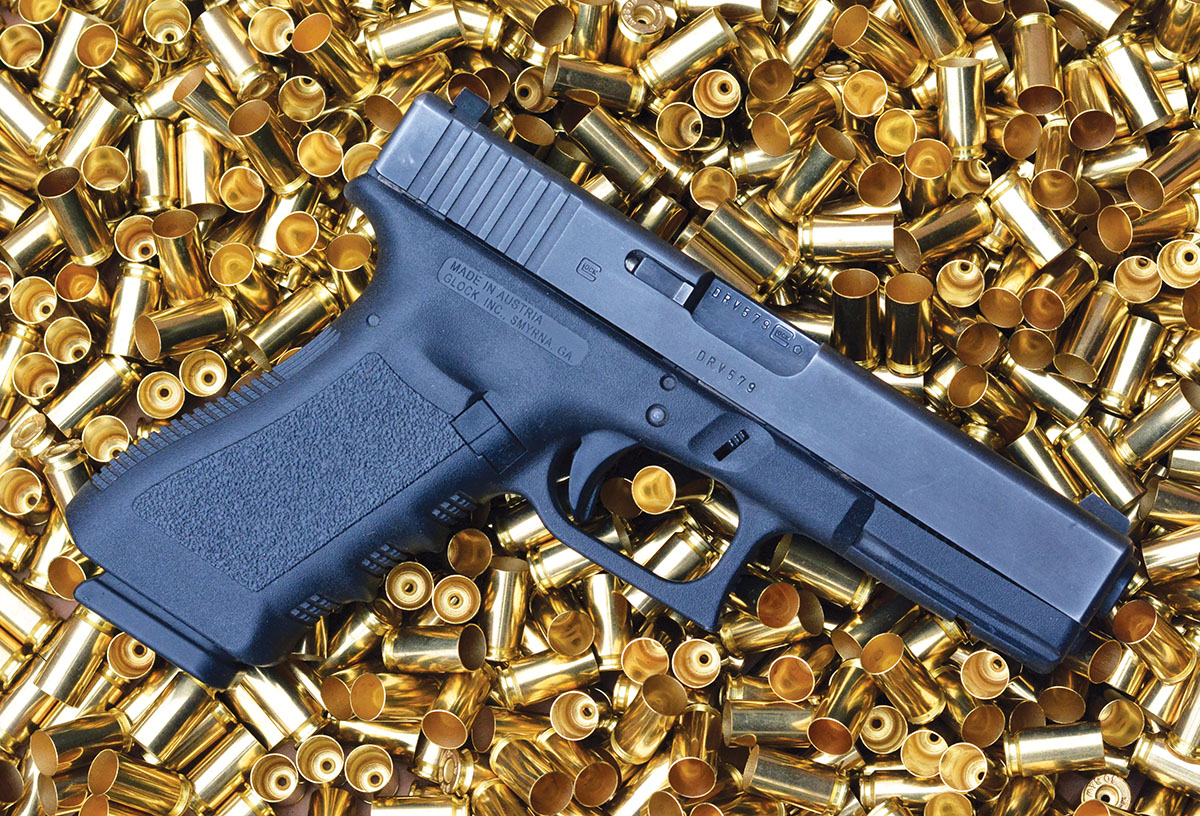
Brian used new Starline brass to develop “Pet Loads” data.
The 40 S&W was formally introduced January 17, 1990, and was a joint effort between Smith & Wesson (S&W) and Winchester Ammunition, which was similar when the two companies worked together developing the 357 Magnum in 1935. It was enthusiastically received by shooters and many divisions of law enforcement including the FBI. As of this writing its popularity is best described as steady (i.e., not growing), but it is nonetheless popular with countless pistols produced. The 40 S&W falls in the middle of two widely popular pistol cartridges including the 9mm Luger and the 45 ACP that were each designed specifically as military rounds. However, each of those three cartridges offers certain advantages over each other.
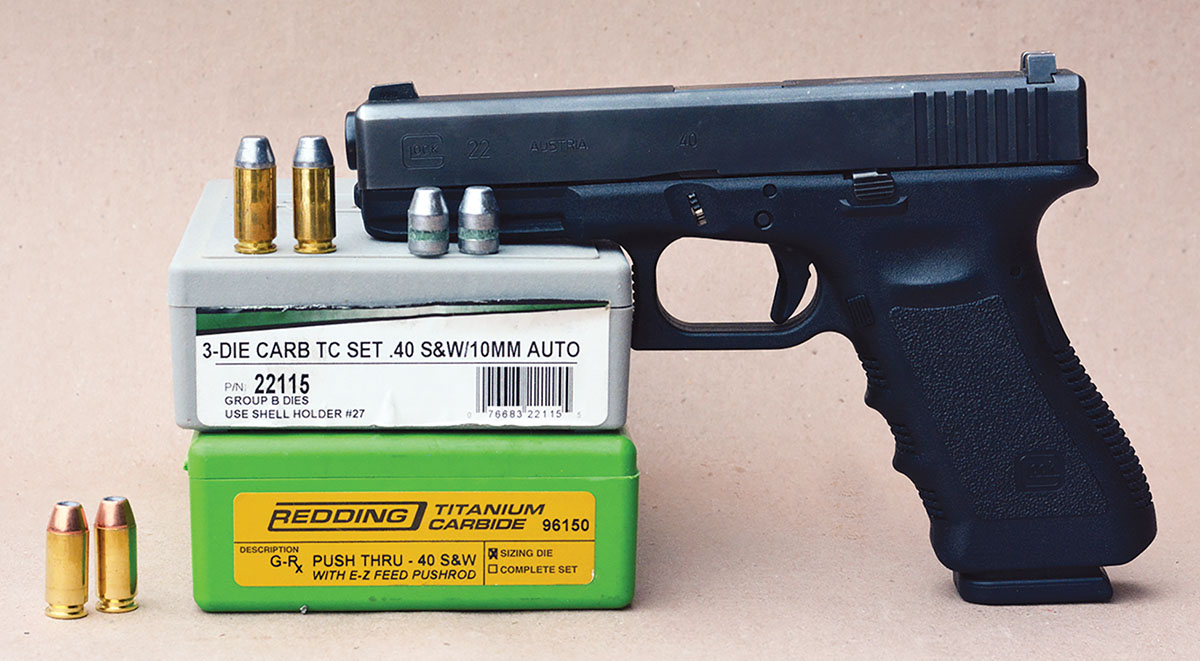
Brian used RCBS carbide dies and a Redding GR-x Push Thru Carbide Die for handloading the 40 S&W.
During the late 1960s and early 1970s, Whit Collins began experimenting with a wildcat pistol cartridge by cutting down 30 Remington cases (not to be confused with 30 Remington AR) and loading them with 180-grain .400 inch bullets designed for the 38-40 Winchester and 401 Herter’s Power Magnum. Collins wildcat was referred to as the “.40 Super and 40 Auto” and was built on modified Browning Hi-Power and Colt Model 1911 pistols.
With coaching from Jeff Cooper, who continued to request greater velocity and power than the Collins original wildcat, a longer version was developed. It gained recognition when Tom Dornaus and Mike Dixon set the final cartridge specifications and introduced the Bren 10 Autoloading Pistol in 1983, with Norma producing a 10mm Auto factory load that pushed a 200-grain bullet at 1,200 feet per second (fps), or a 170-grain at 1,400 fps! Unfortunately the company went bankrupt. However, soon Colt and Smith & Wesson began producing pistols and U.S. ammunition companies offered loads.
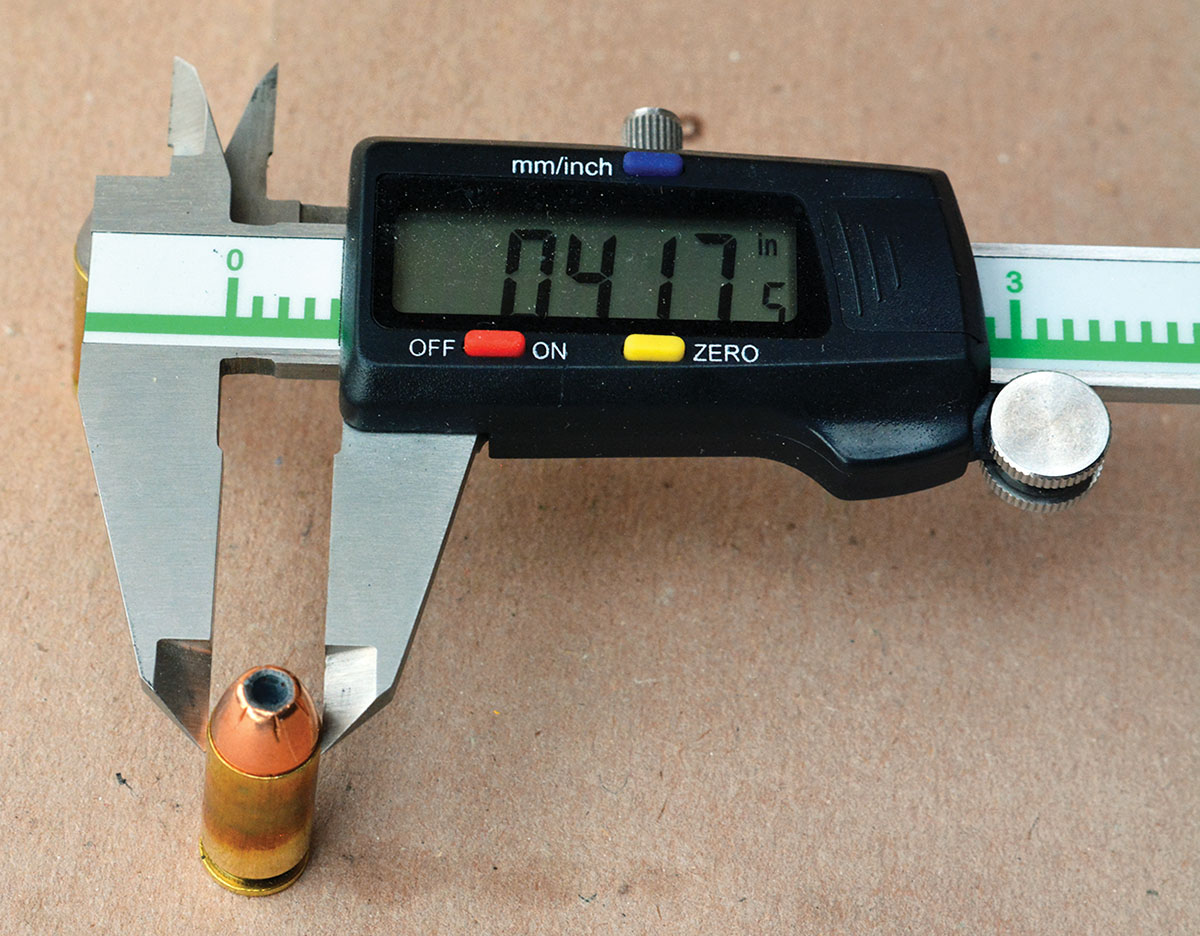
A taper crimp should be applied after bullets are seated to the correct overall cartridge length. Depending on case, make and other factors the crimp should generally measure .417 to .420 inch, but should never exceed .423 inch.

Maximum case length is .850 inch, while suggested trim to length is .845 inch.
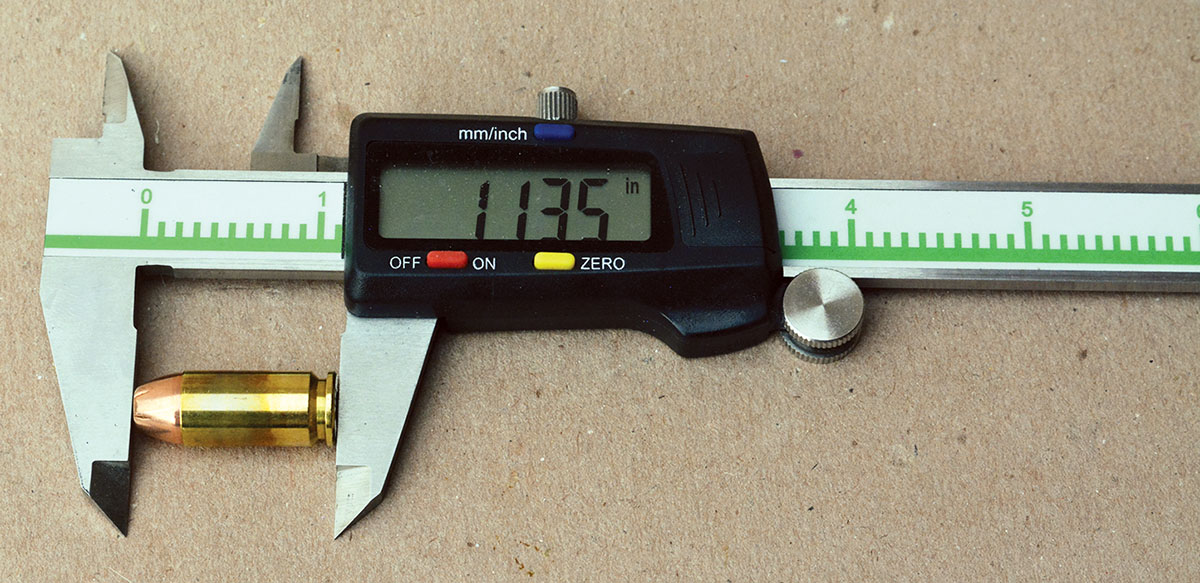
Maximum overall cartridge length is 1.135 inch.
After a disastrous April 11, 1986, FBI shootout in Miami, Florida, the FBI realized that they needed to improve their sidearm choices. The FBI developed a series of eight tests that were realistic situations that agents could face. They primarily chose 9mm Luger and 45 ACP pistols for these tests (as information suggests that they had already determined that the 10mm Auto was too powerful with too much recoil). However, the chief of FBI Firearms Training Unit John Hall elected to use some of his 10mm Auto handloads that pushed 180-grain bullets between 900 and 1,000 fps from his personal Colt Delta Elite pistol. After realizing the virtues of this caliber and power level, along with extensive testing, the 10mm Auto was formally adopted in 1989 that resulted in surging interest from shooters. The FBI contacted Smith & Wesson and requested specifications for a large frame, double action pistol that was based on the Model 4506 45 ACP frame. However, due to the power and recoil of full-power 10mm Auto loads, the FBI eventually requested reduced power loads from Federal Cartridge (and other ammunition companies joined in) that became known as the “FBI Lite, FBI Load or Subsonic” that typically pushed 180-grain bullets between 950 to 1,030 fps. These lighter loads permitted faster follow up shots, but still offered notable terminal performance. While Smith & Wesson was quick to supply the new pistols known as the Model 1076, they immediately recognized that they could shorten the cartridge and fit it into smaller, lighter and more compact pistols and still easily reach the same ballistics and terminal performance of the 10mm FBI Load.
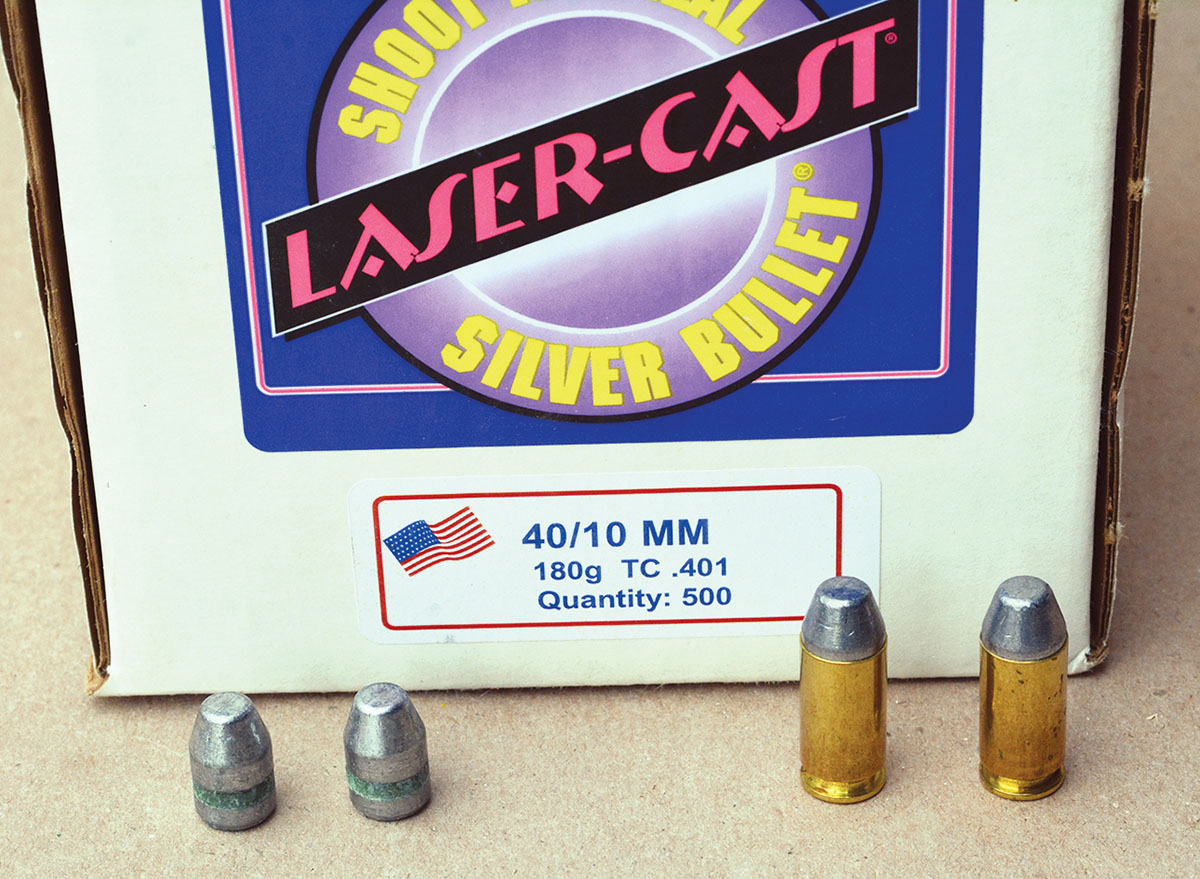
The Oregon Trail Laser Cast offers a 180-grain cast bullet that offers deep penetration, minimal barrel wear and a modest cost.
Essentially the 40 S&W case is a 10mm Auto shortened from .992 inch to .850 inch, naturally with small, but necessary changes including case wall and web thickness, etc., to accommodate bullet length and seating depth. The primer pocket is changed from a large pistol to a small pistol. Incidentally, it is never recommended to shorten 10mm Auto cases to 40 S&W lengths, as higher pressures will occur! The maximum overall cartridge length is 1.135 inch. This resulted in the 40 S&W being suitable for many of the same pistols that house the 9mm Luger. Interestingly, this cartridge is closer to Collins original wildcat in dimensions and ballistics, but that subject must wait for another day. Smith & Wesson’s first 40 S&W pistol was the Model 4006 that was introduced with the new cartridge in 1990. Interestingly, Glock actually offered a 40 caliber pistol, the 22, one week prior to Smith & Wesson introducing theirs, with many other companies soon offering pistols so chambered. The Glock became the most popular of all by a large margin.
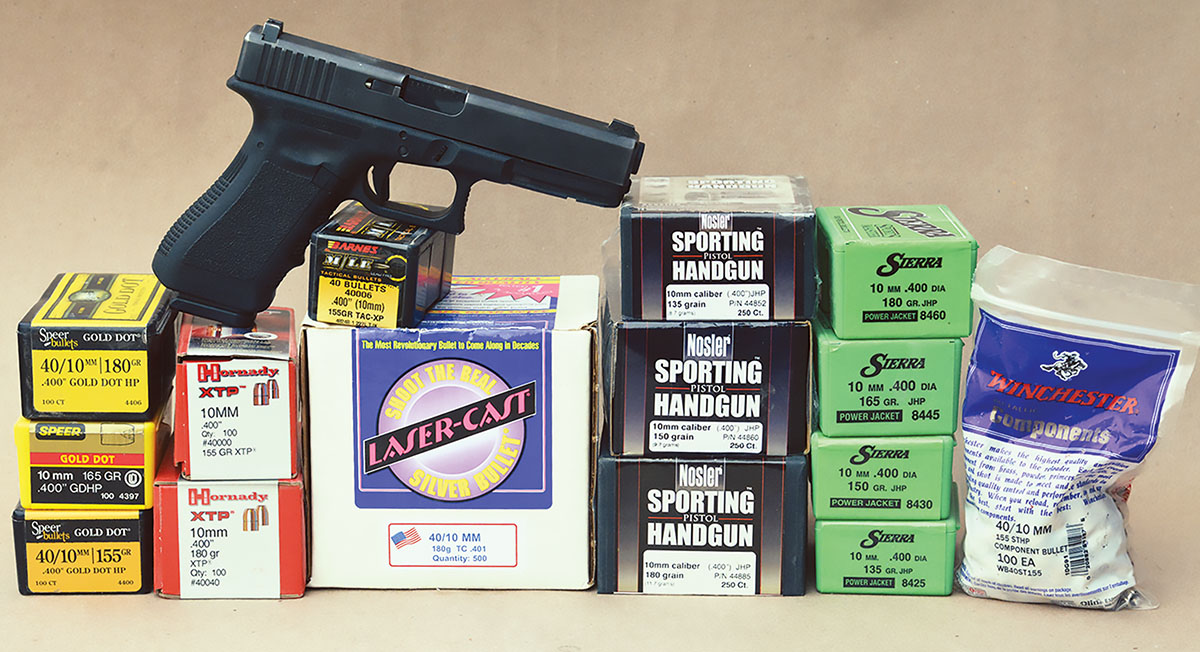
A variety of bullets are readily available for handloading the 40 S&W.
The FBI formally adopted the Glock chambered in 40 S&W in 1997, but many large police departments had previously adopted the same gun and caliber combination and it became the quintessential law enforcement cartridge for more than 25-years. Regardless, it earned an outstanding reputation due to its reliable terminal performance, modest recoil, high magazine capacity, etc. The Federal Assault Weapons Ban of 1994 limited magazine capacity to 10 rounds, so many individuals chose the 40 S&W over the 9mm due to its greater power and identical capacity, but that ban is now lifted.
Ballistics of the 40 S&W have changed very little over the past 35 years. Average velocities with 135-grain bullets are listed at 1,140 to 1,200 fps, 155-grain bullets at 1,140 to 1,205 fps, 165-grain bullets at 1,140 fps and 180-grain bullets at 1,000 to 1,020 fps. SAAMI has established maximum average pressure at 35,000 psi and there are no industry standards for +P loads.
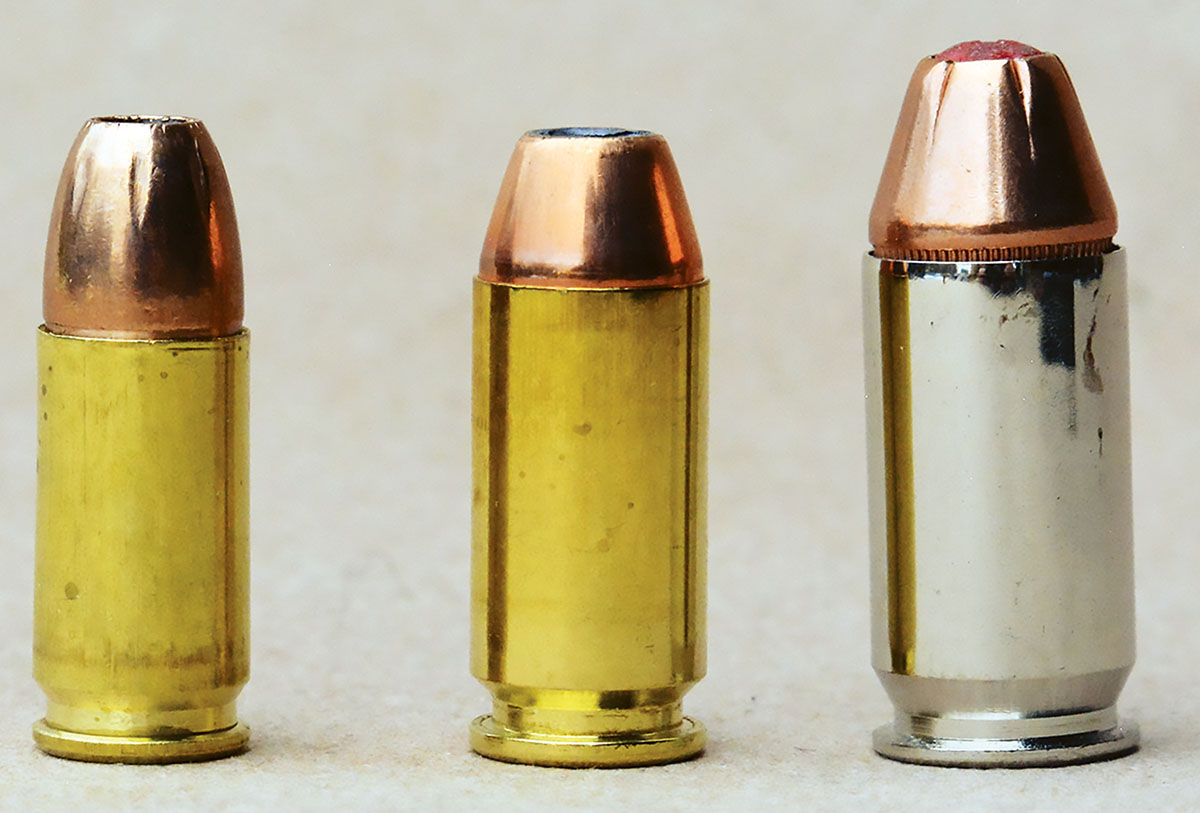
The 40 S&W (center) fills the gap between the 9mm Luger (left) and the 45 ACP (right).
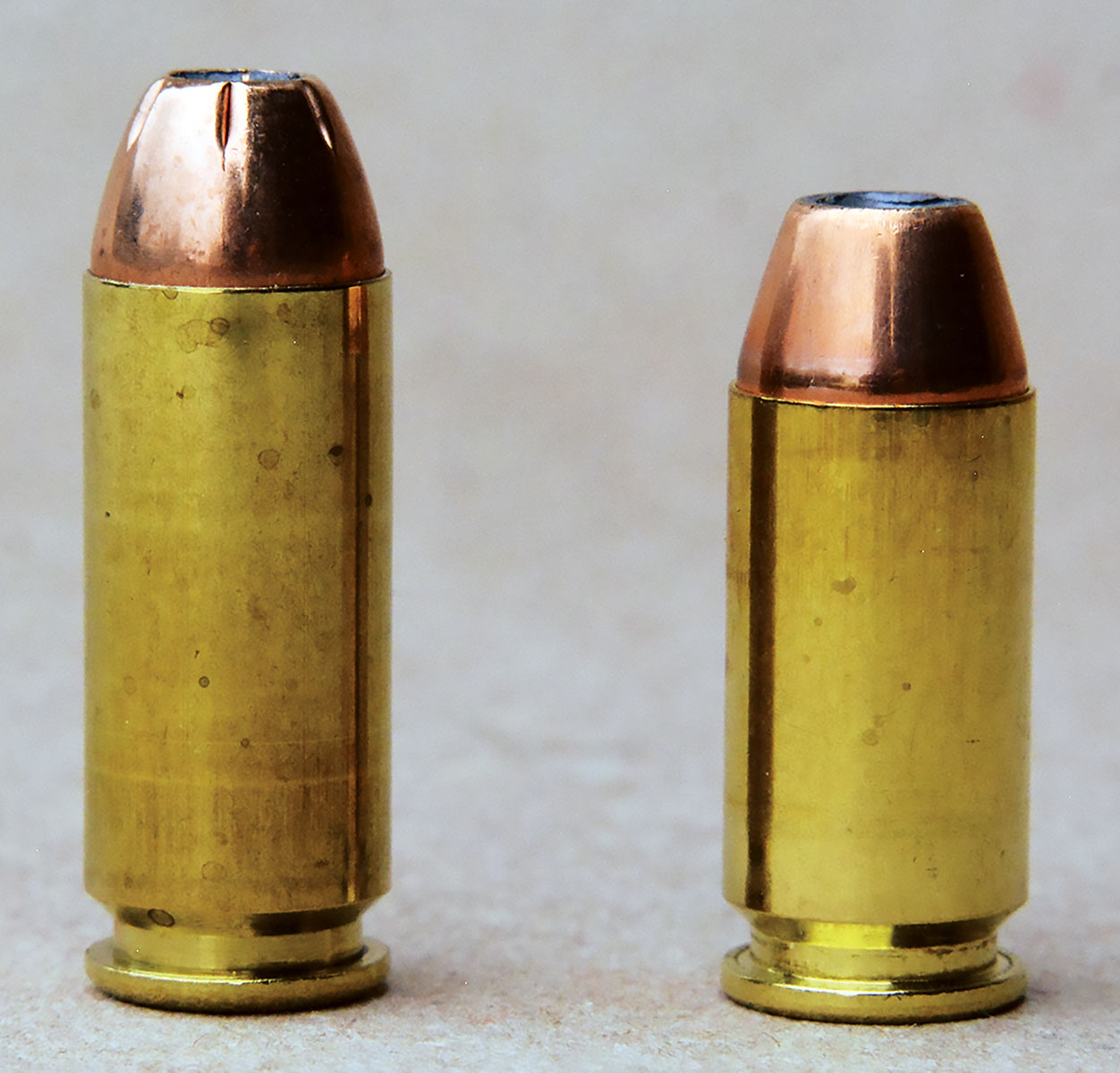
The 10mm Auto (left) is potent and some law enforcement agencies found the recoil excessive. The 40 S&W was developed with a blend of lowered recoil and still offer adequate performance for defensive and law enforcement, but could be offered lighter, smaller pistols.
With a .400-inch bullet diameter, the 40 is truly sandwiched between the 9mm (.355 inch) and 45 ACP (.451 inch). The 40 S&W’s larger caliber and bullet weight options typically weigh 135- to 200-grains and are a distinct power advantage over the 9mm. The 40 S&W FMJ “Ball” style factory loads usually feature a significant meplat that measures around .255 inch, which is still an effective load that delivers notable shock in spite of not offering expansion. However, almost all 9mm FMJ loads are a roundnose design that produce very limited shock. On the other hand, the 9mm offers lower recoil, higher magazine capacity, lower ammunition cost and can be housed in ultra compact pistols. Being a worldwide military round has not only escalated its popularity, but ammunition is available practically everywhere the world over. Many law enforcement agencies have changed to the 9mm, but that switch appears to be something of an effort to standardize with military and reduce ammunition costs and is not based on performance. The old proven 45 ACP boasts of proven big-bore performance, even with less than spectacular bullets and loads, offers comparatively low pressures, but produces more recoil than the 40 S&W. Most guns have less magazine capacity, are larger and the cost of ammunition is greater. Regardless, the 40 S&W is a good cartridge with a unique blend of virtues that make it a worthy choice for defense and other applications. When housed in a true target style pistol, the 40 S&W is exceptionally accurate and capable of producing single digit extreme spreads with select loads.
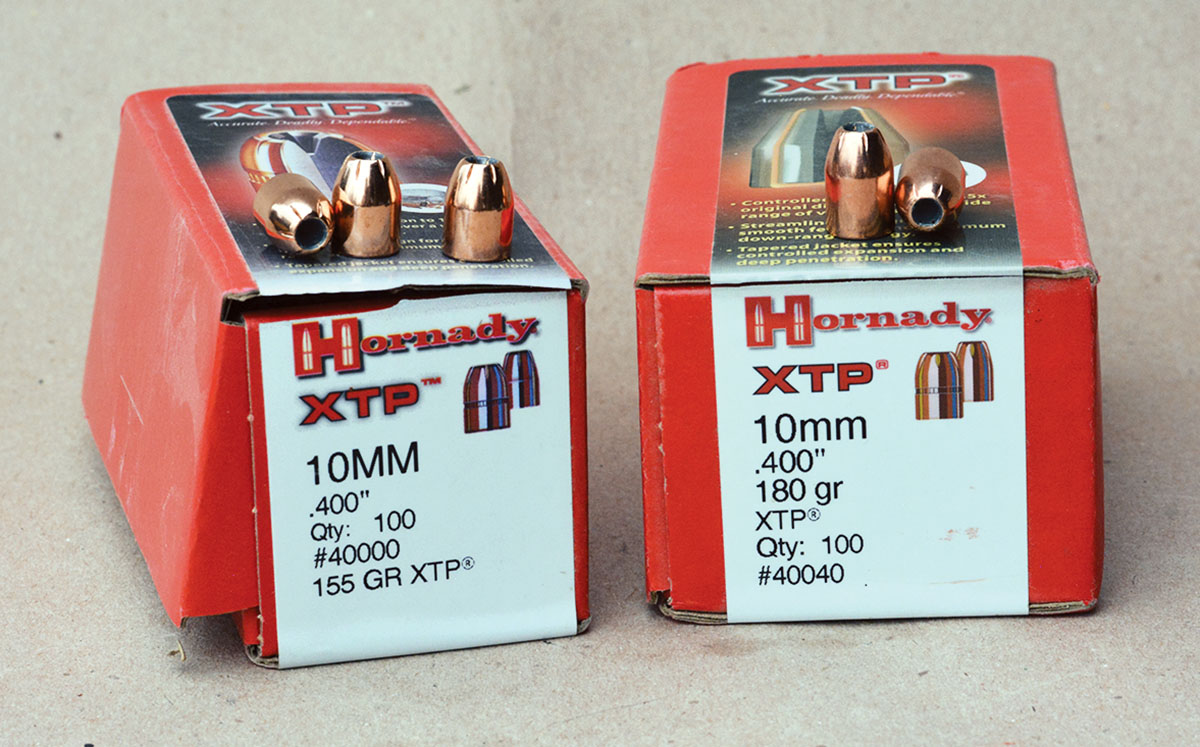
The Hornady Extreme Terminal Performance or XTP in 155- and 180-grain weights are widely popular in the 40 S&W and offered outstanding overall accuracy.
For several reasons a
Glock 22 was selected as the test gun to develop 40 S&W “Pet Loads” data. In addition to being the most common pistol chambered in that caliber, it is reliable and a good test vehicle. The barrel measures 4.35 inch. While definitely not the most accurate pistol out there, they shoot respectable.
This brings us to the “Glock bulge” that appears on cases that are fired in a Glock pistol that handloaders must deal with when reloading cases to obtain reliable handloads. The Glock pistols are commonly referred to as having an “unsupported chamber.” This is not technically correct; however, suffice to say that the bottom of the barrel is ramped rather deeply. When the gun is fired and begins to unlock, pressures are still high enough that the bottom of the case just forward of the head, is unsupported and cases bulge. Third generation and later guns were improved in this area, but they still bulge cases. Incidentally, Glock is not the only gun company that cases exhibit the above bulge.
Loads that exceed industry pressure guidelines are much more prone to rupturing cases and can cause damage to the gun and can possibly injure the shooter. For these reasons maximum loads should not be exceeded!
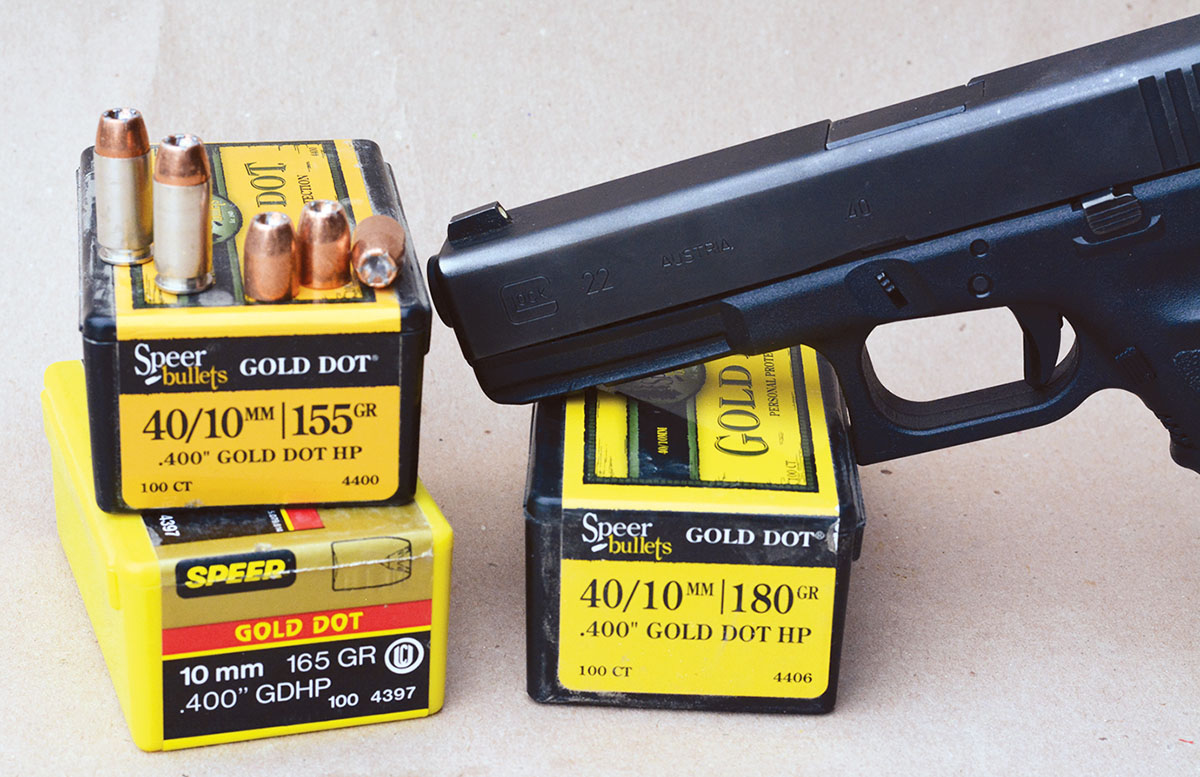
Speer Gold Dot HP bullets in 155-, 165- and 180-grain weights are an excellent choice for assembling premium 40 S&W loads.
One problem is that carbide sizing dies do not remove the bulge in cases just forward of the head, even when the die is adjusted to contact the shell holder. When sized and reloaded, cartridges often will not chamber properly, so the bulge must be removed before the standard reloading steps are performed. The best system that I have tried is the
Redding G-Rx Push Thru Titanium Carbide Sizing Die, which pushes the entire case through the die and completely removes the bulge. Next, cases still need to be full-length sized, neck expanded, etc. in traditional fashion.
This brings us to cases. It is amazing to me that I even have to mention the following problem with a cartridge that is completely modern. Some ammunition companies have developed new methods to manufacture cases that cut costs, but it has resulted in cases having very thin walls. When full-length sized and the case mouth expanded, the .400 inch bullets will drop right into the case to the very bottom. In addition to dimensional issues that will prevent assembling reliable handloads, these cases are weak and are most prone to rupturing when fired with full-house 35,000 psi loads. Such cases are not suitable for handloading and should be discarded.
Starline cases were used herein that are robust and strong and are not prone to rupturing with full-house loads. In addition to the above mentioned Redding G-Rx Push Thru die, RCBS carbide dies were used. After sizing, the neck expanding die should be adjusted to flare the case mouth just enough to allow the bullet to seat without hanging up. Naturally, after sizing, expanding, priming, throwing powder charges and seating bullets to the proper overall cartridge length, a taper crimp should be applied as a separate step. While specifications list the case mouth with an outside measurement of .423 inch, generally speaking this is just not enough crimp to fully secure the bullet. Depending on case make and dimensions, the crimp should measure (using blade calipers) .417 to not over .420 inch. Apparently I am not alone in suggesting that crimp measurement, as many factory loads were checked and each one measured .417 to .420 inch. Keep in mind that the 40 S&W headspaces on the case length and the case mouth, so cases should not be shortened to less than .845 inch and the taper crimp should not be smaller than .417 inch to assure positive headspace control.
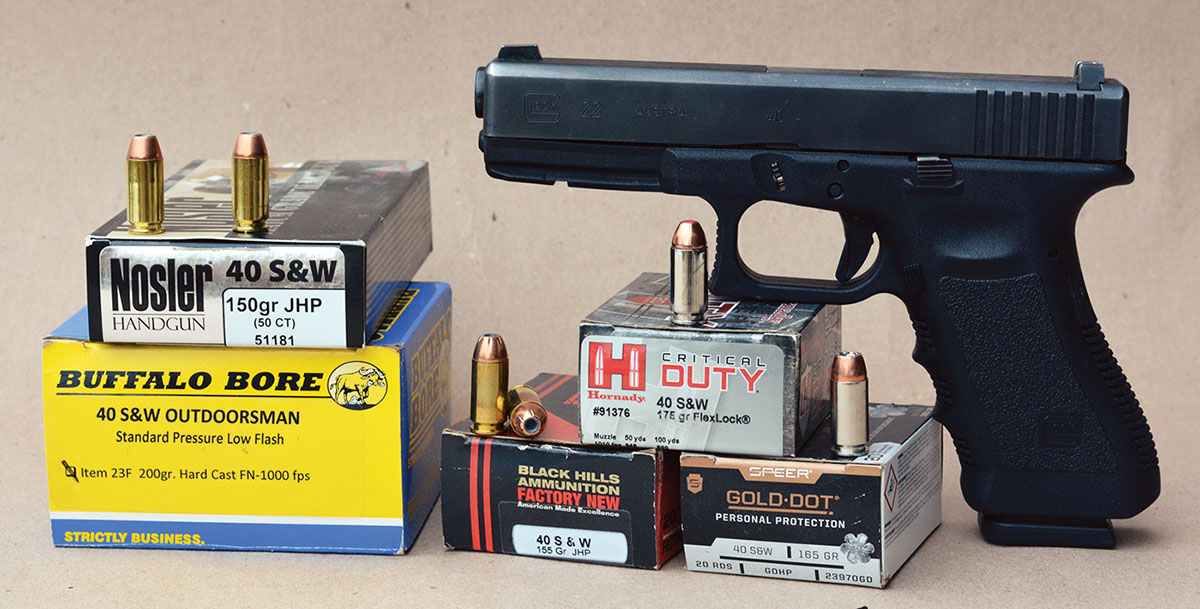
Factory loads were referenced for performance from the Glock 22.
As expected, bullet selection is extensive; however, the most popular are 135-, 150-, 155-, 165- and 180-grain weights. In measuring their length and bearing surfaces, cup and core bullets of the same weight from
Hornady,
Speer, Nosler and
Sierra are very similar. Due to small design differences, jacket material, etc., they will give different pressures from one manufacturer to the next. I was especially pleased with the overall performance of the Speer Gold Dot (155-, 165- and 180-grain weights) and the Hornady XTP (155- and 180-grain weights), which are both excellent choices for defense purposes. The Barnes 155-grain TAC-XP should not be used with any other data fired with 155-grain cup and core bullets. Its total length is .734 inch, while other 155-grain cup and core bullets measure .550 inch or less. The TAC-XP is substantially longer than any other 180-grain or even 200-grain bullets used in the accompanying data. To keep the overall cartridge length correct, the TAC-XP must seat deeper into the case. This substantially reduces powder capacity and many powder and charge weight combinations will not fit, or are heavily compressed (which is not recommended). Even though the TAC-XP is tapered, it still has a substantial bearing surface that also raises pressures.
Due to the 40 S&W’s short length, small changes in bullet seating depth will change pressure. In other words, it is suggested to seat bullets to the listed overall cartridge length, as seating them deeper will raise pressures, sometimes significantly.
Glock does not recommend cast bullets. The problem is the result of using poor quality cast bullet loads that leave a lead buildup just forward of the chamber. If this is not removed prior to firing a jacketed bullet load, pressures will spike and can case cases to rupture, etc. Loads that do not lead, work perfectly. A sample of data is included using the Oregon Trail (now owned by Rim Rock Bullets) 180-grain Truncated Cone style bullet that gave good overall performance.
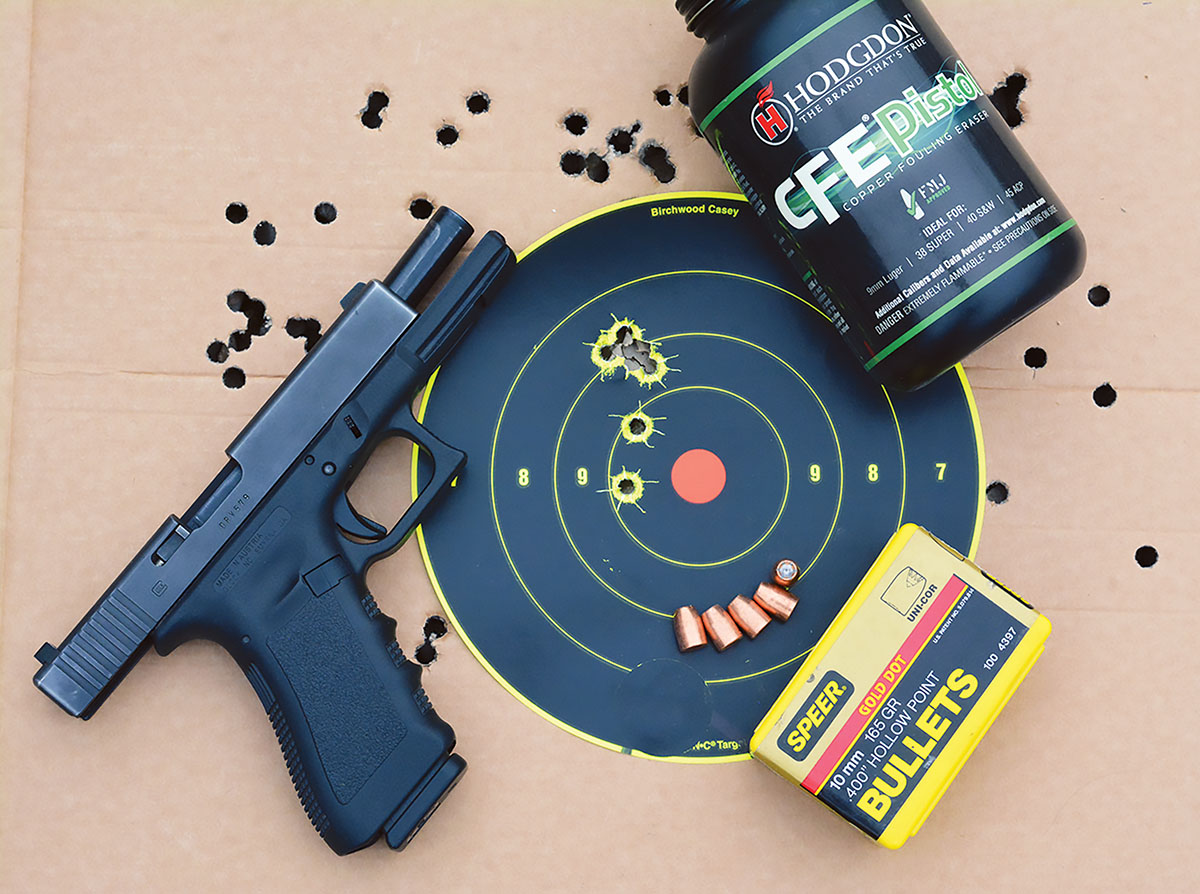
The 40 S&W has the potential for excellent accuracy, such as this handload that contained the 165-grain Speer Gold Dot HP bullet pushed with Hodgdon CFE Pistol powder.
The list of suitable powders for handloading the 40 S&W is extensive. To call out top performers is difficult, as the differences in performance are not huge. In other words virtually all loads performed well. Suffice to say that
CFE Pistol gave excellent general results, boasts of copper fouling eraser technology and was clean burning.
Hodgdon Longshot produced high velocities blended with notable accuracy and should be considered a top choice especially for those wanting high velocity loads.
Hodgdon Titegroup lived up to its name, as accuracy was excellent and it was very clean burning, however, it does not offer top velocities. Winchester 572 proved a great general purpose powder producing respectable velocities and accuracy. Winchester AutoComp is a proven choice that offers a blend of good velocity and accuracy.
Alliant BE-86 performed very well as it produced very low extreme spreads and gave appropriate velocities.
Ramshot True Blue and
Silhouette both offered good accuracy blended with factory load duplication velocities. Again, all loads performed very well, or they were deleted from the accompanying “Pet Loads” data. Regardless, a meticulous handloader can choose components carefully and duplicate or exceed factory load velocities and accuracy.
The 40 S&W is a great pistol cartridge that offers a unique level of performance that lands right between the little 9mm and the 45 ACP.













.jpg)
.jpg)


